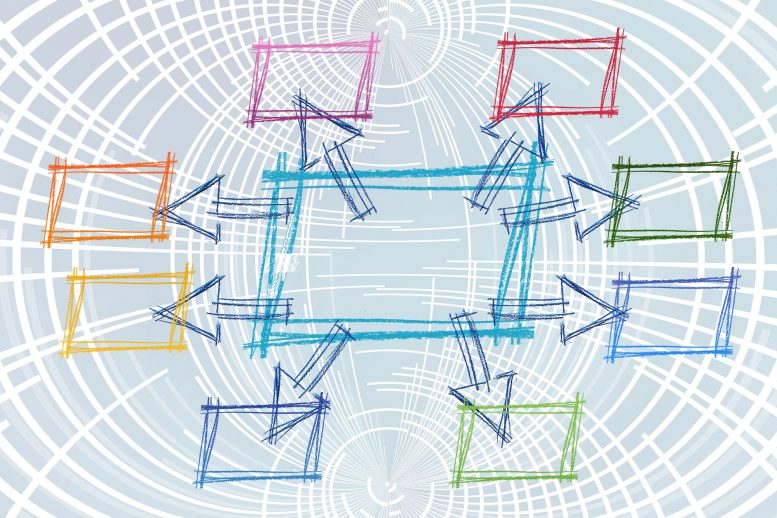
In contrast to prior hypotheses, this experiment shows that people are not born with category systems already in their brains.
Imagine you gave the exact same art pieces to two different groups of people and asked them to curate an art show. The art is radical and new. The groups never speak with one another, and they organize and plan all the installations independently. On opening night, imagine your surprise when the two art shows are nearly identical. How did these groups categorize and organize all the art the same way when they never spoke with one another?
The dominant hypothesis is that people are born with categories already in their brains, but a study from the Network Dynamics Group (NDG) at the Annenberg School for Communication has discovered a novel explanation. In an experiment in which people were asked to categorize unfamiliar shapes, individuals and small groups created many different unique categorization systems while large groups created systems nearly identical to one another.
“If people are all born seeing the world the same way, we would not observe so many differences in how individuals organize things,” says senior author Damon Centola, Professor of Communication, Sociology, and Engineering at the University of Pennsylvania. “But this raises a big scientific puzzle. If people are so different, why do anthropologists find the same categories, for instance for shapes, colors, and emotions, arising independently in many different cultures? Where do these categories come from and why is there so much similarity across independent populations?”
To answer this question, the researchers assigned participants to various sized groups, ranging from 1 to 50, and then asked them to play an online game in which they were shown unfamiliar shapes that they had to categorize in a meaningful way. All of the small groups invented wildly different ways of categorizing the shapes. Yet, when large groups were left to their own devices, each one independently invented a nearly identical category system.
Large Groups Create Predictable Categories
“If I assign an individual to a small group, they are much more likely to arrive at a category system that is very idiosyncratic and specific to them,” says lead author and Annenberg alum Douglas Guilbeault (Ph.D. ’20), now an Assistant Professor at the Haas School of Business at the University of California, Berkeley. “But if I assign that same individual to a large group, I can predict the category system that they will end up creating, regardless of whatever unique viewpoint that person happens to bring to the table.”
“Even though we predicted it,” Centola adds, “I was nevertheless stunned to see it really happen. This result challenges many long-held ideas about culture and how it forms.”
Network Effects and Cultural Uniformity
The explanation is connected to previous work conducted by the NDG on tipping points and how people interact within networks. As options are suggested within a network, certain ones begin to be reinforced as they are repeated through individuals’ interactions with one another, and eventually a particular idea has enough traction to take over and become dominant. This only applies to large enough networks, but according to Centola, even just 50 people is enough to see this phenomenon occur.
Centola and Guilbeault say they plan to build on their findings and apply them to a variety of real-world problems. One current study involves content moderation on Facebook and Twitter. Can the process of categorizing free speech versus hate speech (and thus what should be allowed versus removed) be improved if done in networks rather than by solitary individuals? Another current study is investigating how to use network interactions among physicians and other health care professionals to decrease the likelihood that patients will be incorrectly diagnosed or treated due to prejudice or bias, like racism or sexism. These topics are explored in Centola’s forthcoming book, CHANGE: How to Make Big Things Happen (Little, Brown & Co., 2021).
“Many of the worst social problems reappear in every culture, which leads some to believe these problems are intrinsic to the human condition,” says Centola. “Our research shows that these problems are intrinsic to the social experiences humans have, not necessarily to humans themselves. If we can alter that social experience, we can change the way people organize things, and address some of the world’s greatest problems.”
Reference: “Experimental Evidence for Scale—Induced Category Convergence across Populations” by Douglas Guilbeault, Andrea Baronchelli and Damon Centola, 12 January 2021, Nature Communications.
DOI: 10.1038/s41467-020-20037-y
The study, was published in Nature Communications. Authors include Guilbeault; Andrea Baronchelli, City University London; and Centola. This study was partially funded by a Dissertation Award granted to Guilbeault by the Institute for Research on Innovation and Science at the University of Michigan.
Never miss a breakthrough: Join the SciTechDaily newsletter.
3 Comments
… it looks like this might be connected to a way we use our resources, and one would find it very interesting, as a point, if it looks how humans solve some problems, too.
For an example take spear heads, …
Nicely done! It would seem that this is related to 2 other concepts:
(1) ‘market’ strategies, whereby a market consensus tends to converge to a ‘price point’ that reflects actual value; and
(2) ‘convergence theorems’ in statistics, such as the central limit theorem, show that given more samples, the aggregate statistics converge to a mean or distribution.
While this experiment is categorical and these other concepts are ordinal, it is analogous to multiple logistic regression vs linear regression.
… some limitations are our genes, … it is a bit like a framework that is used as a base to building rest of the thing, but also it is creating the limit for how far one can goo…, as a species …